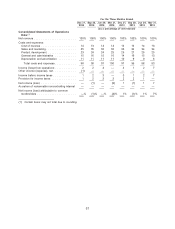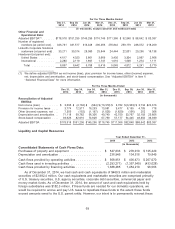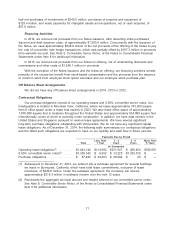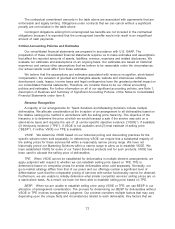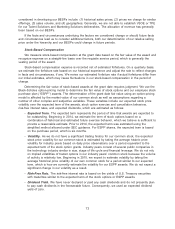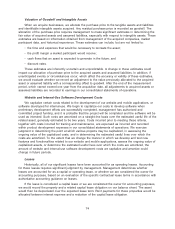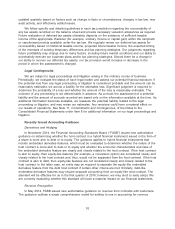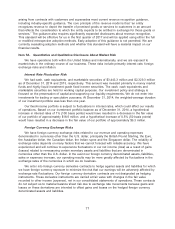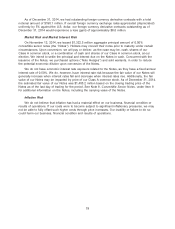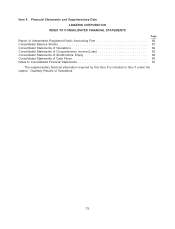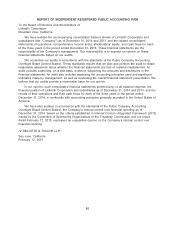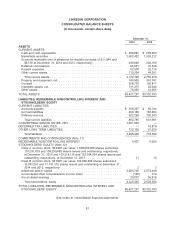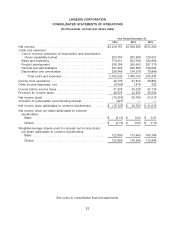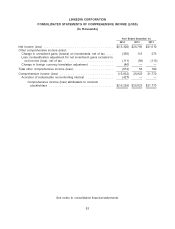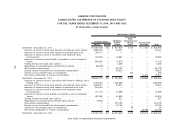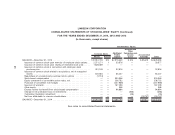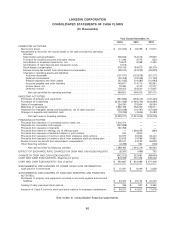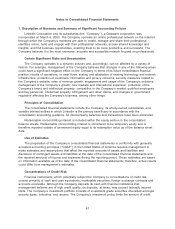LinkedIn 2014 Annual Report Download - page 79
Download and view the complete annual report
Please find page 79 of the 2014 LinkedIn annual report below. You can navigate through the pages in the report by either clicking on the pages listed below, or by using the keyword search tool below to find specific information within the annual report.arising from contracts with customers and supersedes most current revenue recognition guidance,
including industry-specific guidance. The core principle of the revenue model is that ‘‘an entity
recognizes revenue to depict the transfer of promised goods or services to customers in an amount
that reflects the consideration to which the entity expects to be entitled in exchange for those goods or
services.’’ The guidance also requires significantly expanded disclosures about revenue recognition.
This standard will be effective for us in the first quarter of 2017 and will be applied using either the full
or modified retrospective adoption methods. Early adoption of this guidance is not permitted. We are
currently evaluating adoption methods and whether this standard will have a material impact on our
financial results.
Item 7A. Quantitative and Qualitative Disclosure About Market Risk
We have operations both within the United States and internationally, and we are exposed to
market risks in the ordinary course of our business. These risks include primarily interest rate, foreign
exchange risks and inflation.
Interest Rate Fluctuation Risk
We had cash, cash equivalents, and marketable securities of $3,443.3 million and $2,329.3 million
as of December 31, 2014 and 2013, respectively. This amount was invested primarily in money market
funds and highly liquid investment grade fixed income securities. The cash, cash equivalents and
marketable securities are held for working capital purposes. Our investment policy and strategy is
focused on the preservation of capital and supporting our liquidity requirements. We do not enter into
investments for trading or speculative purposes. At December 31, 2014, the weighted-average duration
of our investment portfolio was less than one year.
Our fixed-income portfolio is subject to fluctuations in interest rates, which could affect our results
of operations. Based on our investment portfolio balance as of December 31, 2014, a hypothetical
increase in interest rates of 1% (100 basis points) would have resulted in a decrease in the fair value
of our portfolio of approximately $18.6 million, and a hypothetical increase of 0.5% (50 basis points)
would have resulted in a decrease in the fair value of our portfolio of approximately $9.3 million.
Foreign Currency Exchange Risks
We have foreign currency exchange risks related to our revenue and operating expenses
denominated in currencies other than the U.S. dollar, principally the British Pound Sterling, the Euro,
the Australian dollar, the Canadian dollar, the Indian rupee and the Singapore dollar. The volatility of
exchange rates depends on many factors that we cannot forecast with reliable accuracy. We have
experienced and will continue to experience fluctuations in our net income (loss) as a result of gains
(losses) related to remeasuring certain monetary assets and liabilities that are denominated in
currencies other than the U.S. dollar. In the event our foreign currency denominated assets, liabilities,
sales or expenses increase, our operating results may be more greatly affected by fluctuations in the
exchange rates of the currencies in which we do business.
We enter into foreign currency derivative contracts to hedge against assets and liabilities for which
we have foreign currency exposure to minimize the risk that our earnings will be adversely affected by
exchange rate fluctuations. Our foreign currency derivative contracts are not designated as hedging
instruments. These derivative instruments are carried at fair value with changes in the fair value
recorded to other income (expense), net in our consolidated statements of operations. These contracts
do not subject us to material balance sheet risk due to exchange rate movements because gains and
losses on these derivatives are intended to offset gains and losses on the hedged foreign currency
denominated assets and liabilities.
77


